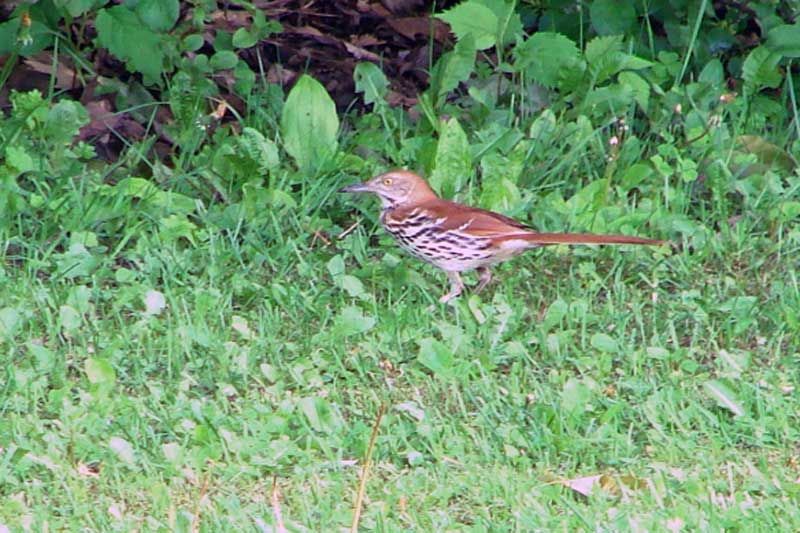Steve Blight | Jun 12, 2013
By Steve Blight
A couple of weeks ago Wendy Hinch, a reader living in the Sydenham area, e-mailed me a picture of a bird and was wondering if it could be a Brown Thrasher. The picture clearly showed a slim, robin-sized bird with a rich, chestnut-coloured back and tail, dark streaking on the whitish underparts, long sturdy legs and a long slightly down-curved bill. Indeed, the bird was a Brown Thrasher.
Brown Thrashers are not rare birds in eastern Ontario, but neither are they particularly common. Most years I see a small number of thrashers, usually in the early spring shortly after they have returned from their extended winter vacations in the southern US and before the leaves are out on the trees. Arriving in our area in April, they can survive on the previous year’s berries until the weather warms up to the point where their invertebrate prey becomes active. The animal portion of their diet includes a number of creatures that some humans are not very fond of – beetles, grubs, wire-worms, army worms, cutworms, tent caterpillars, gypsy-moth caterpillars, leafhoppers, grasshoppers, crickets, wasps and sowbugs. One gets the feeling that if it’s small enough and crawls or flies, this bird will try to eat it! The fruit portion of their diet includes blueberries, elderberries, Virginia creeper and sumac berries, raspberries, currants and grapes.
There is only one thrasher species east of Texas. In parts of the southwestern US there can be up to eight different thrashers, making identification quite a challenge. Our job is much easier – here only the Wood Thrush is likely to cause any confusion. However the Wood Thrush is a plumper bird, and does not have the thrasher’s characteristic long bill and tail.
Thrashers are good singers – like catbirds and mockingbirds, they are able to crudely mimic other bird songs and have extremely varied repertoires. The male sings a loud, long series of doubled phrases with no definite beginning or end, described by some people as “plant a seed, plant a seed, bury it, bury it, cover it up, cover it up, let it grow, let it grow, pull it up, pull it up, eat it, eat it.” While mockingbirds tend to repeat phrases three or more times and catbirds only once, Brown Thrashers typically sing phrases twice before moving on.
Thrashers are birds of shrubby areas, hedgerows and young second growth forest edges. As such they benefited greatly from the opening up of eastern forests by European settlers for farms and homesteads. However, in recent decades their shrubby habitat has been disappearing across southern Ontario and elsewhere – old farmlands are regrowing into forests, being cleared to grow cash crops and being gobbled up for housing and industrial developments. It has been estimated that the population of Brown Thrashers in some parts of southern Ontario has dropped by over 60% since 1968.
Here are a few more interesting thrasher facts to end with. Both males and females help incubate the eggs and feed the young. Nestlings sometimes leave the nest fully feathered within nine days of hatching. Brown Thrashers are the largest common host of parasitic Brown-headed Cowbirds – but thrashers put up some resistance, often rejecting cowbird eggs that are laid in their nests. And finally the oldest Brown Thrasher on record was at least 11 years, 11 months old. It was recaptured and then re-released at a Florida banding station. Long live Brown Thrashers!
Please feel free to report any observations to Lorraine Julien at This email address is being protected from spambots. You need JavaScript enabled to view it. or Steve Blight at This email address is being protected from spambots. You need JavaScript enabled to view it.
More Stories
- Latest CUPW Job Action Stops Postal Delivery Of The Frontenac News Forcing Alternate Plans
- Opponents of Barbers Lake Gravel Pit Pack Ag Hall in McDonalds Corners
- Bobsleigh Olympian Jay Dearborn At Mikes Pizza In Sydenham
- The Loins Club Of and O'Lakes Roar
- North Frontenac Back Roads Studio Tour - September 27 and 28
- Sunday Market Vendors Give Back
- George Street Work As Town Hall Renovation Nears Completion
- One Way Street Plan Hits A Dead End - Central Frontenac Council, September 9
- Global Gardening
- No Winner Yet in Catch The Ace But Fundraising Target Met

